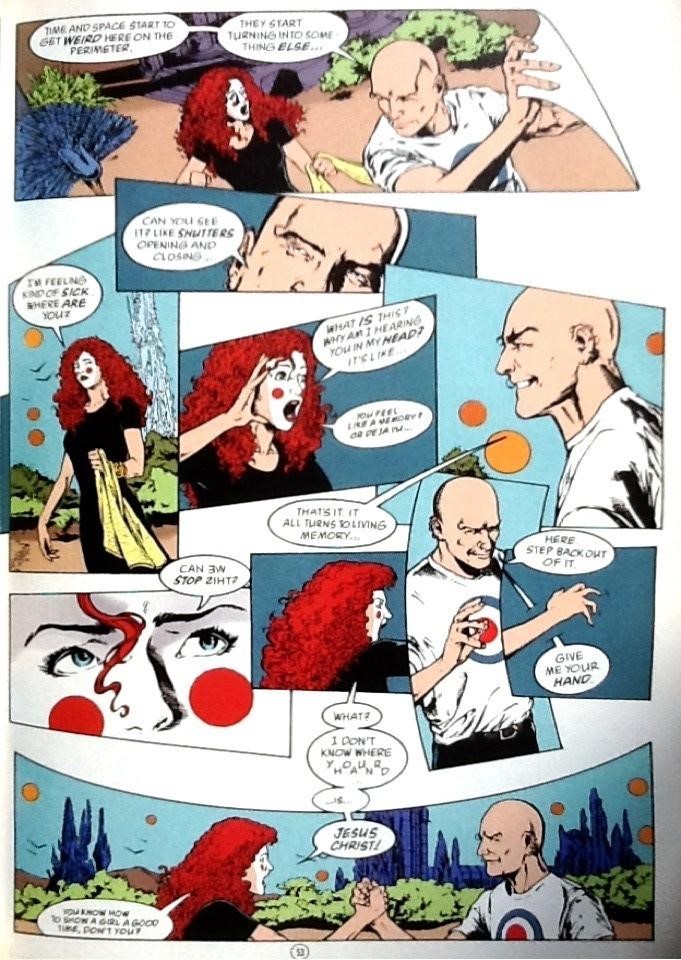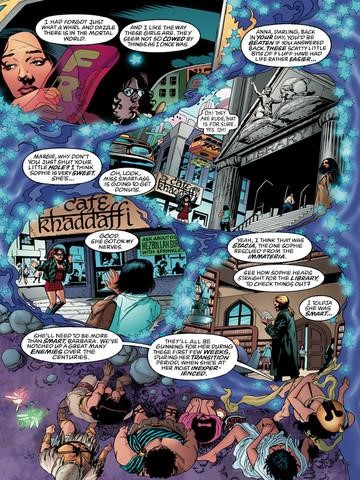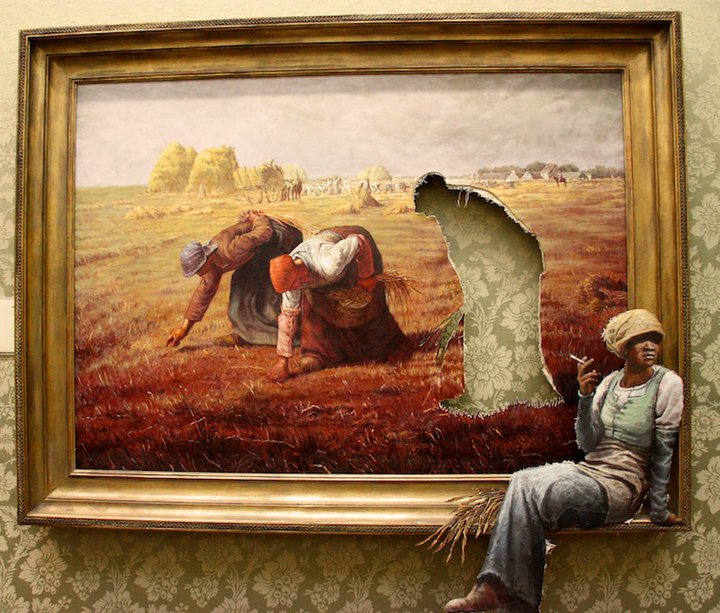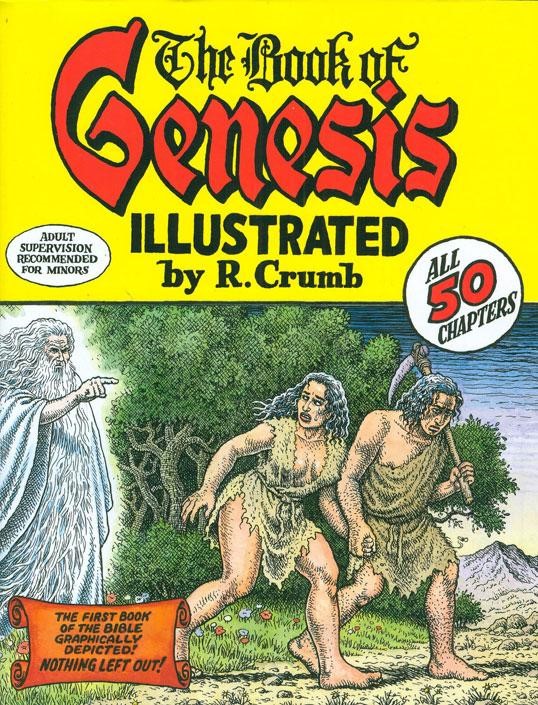At several points during his most recent interview with the Religious Studies Project, A. David Lewis alludes to the prominence of religious themes and images in comic books. In fact, if anything, Lewis downplays just how obvious the connection is. There are at least three intersections. Firstly, and explored at length in this interview, are the implicit and frequent utilisation of religious and mythical stories – particularly concerning death and rebirth – recast with superheroes rather than deities, and often reframed in scientific (or “scientistic”) language. Second, explicit religious narratives are frequently found in comics – consider Will Eisner’s A Contract with God, Craig Thompson’s Habibi, Robert Crumb’s literal presentation of Genesis or more prosaically, Marvel’s Thor. Not forgetting the ubiquitous Christian fundamentalist comics, or Chick Tracts after their primary producer Jack Chick, which due to their massive print runs are often considered to be the world’s most-read comics. Finally, comic books frequently include alternative or heterodox religious ideas, something underscored by the fact that two of the most acclaimed writers working today (Alan Moore and Grant Morrison) are practising magicians, and their work frequently contains references to their practises.
For some reason, then, there is something about comics that makes them particularly suited to discussing such ideas. Here, I will suggest some structural reasons why this might be the case. But I will also present a more sociological possibility, that comics and a heterodox approach to religious ideas go hand in hand, because both are typical features of the cultic milieu (Campbell 1972). As such, the analysis of religious themes in comic books needs to go beyond merely structural analyses.
Structural connections

Darby Orcutt’s chapter, “Comics & Religion: Theoretical Connections” (in the Lewis-edited Graven Images), suggests two reasons why the comics medium is particularly suited to narratives concerning religion. Firstly, drawing from McCloud’s seminal Understanding Comics (1993), he argues that comics allow a greater degree of identification than would be possible with a movie or a novel because of their ability to be deliberately vague about certain aspects.
McCloud notes that the iconic, simplified faces of the protagonists typical of the Japanese Manga comics style makes the protagonist more easily relatable, and this might suggest one reason for the many comics with simplistic protagonists in more realistically drawn worlds (Cerebus the Aardvark, Concrete, Bone, etc).
A second factor outlined by Orcutt is the manipulation of the readers’ perception of time and space. In comics, time can be slowed down and sped up, and future and past can be shown side-by-side. Moreover, by utilising the gutter – the space between the panels – it becomes very easy for the mythical world to be shown, literally outside of the bounded time of the panels, but interacting with the present. Douglas Rushkoff’s Testament makes great use of this technique, as does Alan Moore’s Promethea, from which the following page is drawn.
 One particularly striking and effective version of this – which also includes Lewis’ comment that comics seem unusually aware of the limitations of the genre – is to have enlightenment illustrated by having the characters fall out of the 2D, panel-bound pages, and see them from the three-dimensional point of view of the reader. This happens in Moore’s Promethea and Morrison’s The Invisibles, but there are many other examples. A striking variant found in recent works by both, Moore’s League of Extraordinary Gentlemen: The Black Dossier and Morrison’s Superman Beyond, have used 3-D colouring techniques to indicate when a character has stepped from the ‘flat’ world of the comics page and out into a world with (literally) more depth. While there are many literary examples of such metatextuality – notable examples being the characters meeting their author in Alasdair Gray’s Lanark and Stephen King’s The Dark Tower, although acknowledgement that the text was in fact a text dates back to Don Quixote, at least – the characters do not step off the page in quite the same way. Perhaps this is because comics combine both text and images, so one can be played off another. Interestingly, both Moore and Morrison take this further than mere analogy, and argue that when viewed from a higher level, we the readers are literally works of fiction ourselves… But that is a post for another day.
One particularly striking and effective version of this – which also includes Lewis’ comment that comics seem unusually aware of the limitations of the genre – is to have enlightenment illustrated by having the characters fall out of the 2D, panel-bound pages, and see them from the three-dimensional point of view of the reader. This happens in Moore’s Promethea and Morrison’s The Invisibles, but there are many other examples. A striking variant found in recent works by both, Moore’s League of Extraordinary Gentlemen: The Black Dossier and Morrison’s Superman Beyond, have used 3-D colouring techniques to indicate when a character has stepped from the ‘flat’ world of the comics page and out into a world with (literally) more depth. While there are many literary examples of such metatextuality – notable examples being the characters meeting their author in Alasdair Gray’s Lanark and Stephen King’s The Dark Tower, although acknowledgement that the text was in fact a text dates back to Don Quixote, at least – the characters do not step off the page in quite the same way. Perhaps this is because comics combine both text and images, so one can be played off another. Interestingly, both Moore and Morrison take this further than mere analogy, and argue that when viewed from a higher level, we the readers are literally works of fiction ourselves… But that is a post for another day.
Cultic milieu
As noted above, however, comics concern themselves disproportionately with heterodox and alternative religious ideas – lots of ‘funny ideas’ in these ‘funny books’. Comics are as much a part of the cultic milieu as alternative religions (see Kripal’s recent Mutants and Mystics) – what better place for ‘not real religion’ than in ‘not real literature’? As indicated by the frequency of the descriptor “alternative”, the cultic milieu exists not as a free-floating pool of religious ideas, but to a considerable degree as that which is self-consciously alternative to the social norm.
From this point of view, it is not so surprising that comics would be so prominent. Comics and cartoons (their non-sequential variant, although this is not always so clearly delineated) have a long history of operating as social critique, a tradition that goes back to Hogarth in the mid 18th century, and most recently played out in the Charlie Hebdo affair. I therefore ask, if the religious narratives concerned here operate in some way as a critique of more traditional religious narratives and institutions, does this therefore indicate that this critique is a particular concern among the demographic who read comics? Indeed, comics traditionally have a strong anti-clerical bias (Wilson 2010), suggesting an active attempt to reclaim these symbols of transcendence from elitist discourses. So long as we focus only on structural or narrative similarities, we may be missing the most interesting points.
Like religion(s), comics do not exist as sui generis artefacts, separate from their cultural context. We cannot treat them as naive material artefacts, nine-panel hierophanies which “manifest” or “embody” some eternal religious essence, but as a part of a much larger discourse on “religion” (term, not thing) – which goes on both in elite, official cultural products and unofficial, alternative ones, like comics. Therefore it is vitally important for a non-essentialist and non-elitist study of religion that we consider comics in their cultural and historical context. Without that, structural analyses may be merely repeating hegemonic categories and structures of power. As scholars we need to fall off the page, and see the panels which form the boundaries of our thought.
References
Campbell, C. (1972) “The Cult, the Cultic Milieu, and Secularization.” in A Sociological Yearbook of Religion in Britain 5. (London: SCM Press), 119-136.
McCloud, S. (1994). Understanding comics: [the invisible art]. (New York: HarperPerennial).
Orcutt, D. (2010) “Comics and Religion: Theoretical Connections.” In Lewis, A. D., & Kraemer, C. H., Graven images: Religion in comic books and graphic novels (New York: Continuum), 93-106.
Wilson, G. W. (2010) “Machina ex Deus: Perennialism in Comics.” In Lewis, A. D., & Kraemer, C. H., Graven images: Religion in comic books and graphic novels (New York: Continuum), 249-257.





